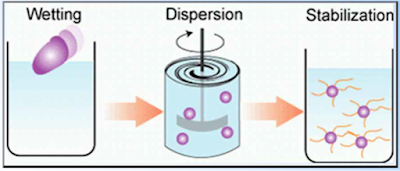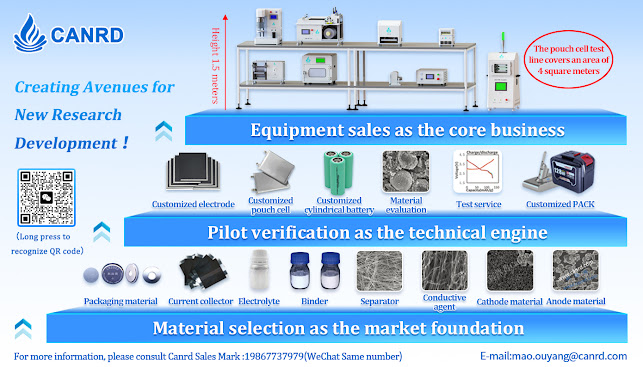Lithium-ion Full Battery Manufacturing Process Training
1. Basic Knowlege Of Mixing
Slurry mixing is the process of adding active materials, conductive carbon black, dispersants, binders, additives, and other components to a mixing equipment in a certain proportion and order. Under the mechanical actions such as turning, kneading, and shearing generated by the equipment, these components are mixed together to form a uniform, stable solid-liquid suspension system suitable for coating.The goal is to achieve uniformity and consistency on both the macro and micro levels.
 |
Wettability, dispersion, and stabilization are the three key indicators of good slurry
 |
1.1 Wettability
Good wettability can reduce the difficulty of dispersion and improve mixing efficiency.
Mechanical stirring dispersion refers to the process of causing strong turbulent motion of the liquid flow through intense mechanical stirring, which leads to the breakup and suspension of particle aggregations.1.3 Stabilization
- Universities mainly use magnetic mixing and ultrasonic dispersion. Advantages: Less material usage. Problem: Poor dispersion effect.
- Commercial mixing primarily uses planetary mixing. Advantages: excellent dispersion effects. Problem: requires a larger amount of material.
- The mixing tank has both revolution and rotation (dispersion disk)
- The tank is equipped with a circulating cooling water system to control the temperature of the entire slurry.
- The tank has a vacuum pump to remove bubbles.
3. Mixing process
 |
| The figure shows the general mixing process (revolution speed~20rpm) |
4. Preparation of PVDF Glue Solution
5. Slurry Dispersion
7. Canrd Brief Introduce
8. Q & A
During the Q&A session at the end of the course, everyone was more enthusiastic and raised many questions. Dr. Ke patiently answered each question and also collected suggestions for the course.
Zhou Xuanyi: "What kind of effects do bubbles in the slurry usually have?"
- Dr. Ke: "If there are bubbles in the slurry, there will be pits on the surface of the electrode sheet during coating, affecting the coating appearance."
Ru as the First Sight: "If the electrode sheet surface has pits, will it affect the separator?"
- Dr. Ke: "Pits on the surface of the electrode sheet will definitely affect it. Firstly, it leads to uneven mass distribution and poor uniformity. When used in battery production, it may apply varying stress on the separator, which makes it harder to assess the separator's performance accurately."
Ke Qing: "Is there a standard for determining moderate viscosity?"
- Dr. Ke: "Different formulations, such as different binder contents, and different materials like cathodes and anodes, have differences in BET and morphology. So, 'moderate' is a qualitative term. Simply put, it should have good flowability. With experience, you develop a range where the flowability, coating appearance, and surface density uniformity are optimal."
Ke Qing: "Does our country currently rely entirely on imports for battery-grade CMC?"
- Dr. Ke: "Japan's CMC is widely used domestically, but there are also domestic alternatives."
Free Fall: "What's the difference between using LA133 adhesive and SBR? Does PAN type have shear rate requirements, and how much could damage it?"
- Dr. Ke: "LA133 is a PAN-based binder with viscosity, so it can replace CMC+SBR. However, its thickening effect is not as strong as CMC, so some is still added. For PAN binders, we currently believe they are less demanding on shear rate, unlike SBR, which may coagulate under high shear."
Blossoms Full of Xin: "Does using different binders have a significant impact on battery capacity?"
- Dr. Ke: "It depends on your application. The binder content in the electrode sheet is usually low. These polymers mainly provide adhesion, but excessive use increases internal resistance because they are non-conductive. As material technology advances, new binders with functional groups for ion conductivity are being developed, which may affect performance at higher rates."
Blossoms Full of Xin: "Which binder is more beneficial for increasing energy density?"
- Dr. Ke: "The best binder has high bonding strength, low usage, and can partially conduct ions."
Eulo: "How do you test electrode sheet internal resistance? Also, how long can cathode and anode generally be stored?"
- Dr. Ke: "Testing internal resistance depends on contact area, pressure, and equipment precision. We view it as a qualitative tool; only when group differences exceed intra-group variance does the test have meaning. For slurry testing, the one-week requirement might be an extreme case, mainly for comparative purposes."
Ai Te: "Does SBR floating blue affect the dispersion uniformity in the electrode sheet?"
- Dr. Ke: "In our experience, SBR floating blue does not affect dispersion uniformity. Here are some tips to reduce SBR floating blue: 1. Minimize slurry settling time by using low-speed stirring instead of static settling; 2. Conduct compatibility tests among CMC, SBR, and graphite to select the right CMC-SBR combination; 3. Modify SBR so its surface functional groups interact with CMC, anchoring SBR to CMC to reduce floating."
Zhou Xuanyi: "Teacher, what causes severe agglomeration and uneven distribution in battery slurry? Manual grinding takes at least an hour to reach coating consistency."
- Dr. Ke: "Is your material’s BET high? High-BET materials are prone to agglomeration and require time to disperse."
Cat Fairy: "Is CMC a surfactant?"
- Dr. Ke: "CMC is not strictly a surfactant; it is mainly a thickener but can affect the wettability of graphite in water."
Gao Feng, Dongguan University of Technology, Battery Materials: "Can CMC be replaced by other substances?"
- Dr. Ke: "CMC is widely used, and alternatives exist but are less effective, such as PAA."
Wuhan University of Technology: "What are secondary particles?"
- Dr. Ke: "Secondary particles are formed when many flake-like graphite particles group together. You can see this in SEM images."
Lee: "Is there a big impact from grinding or magnetic stirring in research?"
- Dr. Ke: "In a previous session, we discussed that ball milling is not recommended; magnetic stirring is preferable (you can check the official notes from the first session on the 'Kerud' public account)."
Fate with You: "What are the usual control levels for anode solid content and viscosity, and how do they relate to the active material ratio?"
- Dr. Ke: "Anode solid content is generally around ~48%, varying by material and formula. Viscosity is usually controlled between 1500 and 4500. The less CMC and SBR used, the better, as it increases energy density."
Blue Storm: "What’s the difference between the PVDF we use and this?"
- Dr. Ke: "PVDF has two functions: providing viscosity to stabilize the slurry, similar to CMC, and offering adhesion, which CMC lacks."
Cat Fairy: "Why does reducing CMC increase energy density?"
- Dr. Ke: "Because CMC does not provide energy, reducing its content leaves more space for active material, thus increasing energy density."
Just a Boy: "Does adding binder to active components make them non-conductive?"
- Dr. Ke: "Partly correct. SBR is indeed non-conductive, but the amount added is limited, so it doesn’t make the whole electrode non-conductive. Generally, SBR is non-conductive to both electrons and ions, with electrons conducted via SP and ions via the electrolyte. However, some new binders with polar functional groups, like PAA and PAN, can conduct ions."



















No comments:
Post a Comment